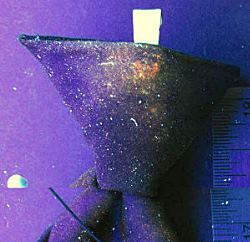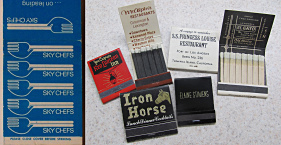|
Fact: UV light illuminated thousands of particles and many stains on the tie. Fact: Particles pulled from the stained areas had the same elemental signatures as the the other match particles. |
|
In August 2011, a second trip was arranged and particle-collection equipment was transported to the FBI office in Seattle in order to image and sample Cooper's tie. Ultraviolet light (UV) and laser florescence was chosen since a large majority of compounds will fluoresce different colors when exposed to ultraviolet or laser light [1,2]. From the previous samples taken in 2010, it was known that the tie contained numerous particles but their distribution on the tie was completely unknown. Fluorescence also allows identification of individual areas that may hold completely different particles due to smudges etc. Besides the UV light, a green laser with blocking filter was used to fluoresce compounds that do not normally fluoresce under UV. Methods A MEJI stereo microscope was mounted on the stage and a standard fluorescent ultraviolet light or "Black Light" was mounted below the objectives to illuminate the tie that was pinned to a movable board (Fig 1). Additionally a 532 nanometer (nm), 200 milliwatt green laser was mounted above the microscope that projected a laser dot on the tie in the field of view. A 532 nm long pass blocking filter could be moved into the optical path to block the glare from the laser and allow visualization of the fluorescing particles. The tie was sequentially photographed at high resolution along its length and the images were subsequently stitched together using Photoshop. Stains and anomalies on the tie were closely inspected and sampled using sticky stubs. Using electron microscopes, energy dispersive x-ray spectroscopy (EDS) was performed on hundreds of particles sampled from the tie. EDS reveals the atomic makeup of very small particles down to a few microns. The elemental signatures were compared to known samples or the SLICE database of elemental signatures. Discussion Figure 2 is the UV tie composite. A full resolution image can be obtained by clicking on the photo. The first notable feature is that there are literally tens of thousands of particles on the tie. This considerable number of particles suggests that the tie was in daily use for an extended time. Cooper's tie can be compared to a similar vintage tie in Figure 3 that was worn occasionally and has considerably lower particle count. This demonstrates that ties not in continuous use acquire little in terms of particle load. There are at least a dozen significant localized stains on the tie. Generally speaking, the majority have similar color characteristics suggesting that they resulted from similar processes. The stains were specifically targeted with sticky tape samples for the electron microscope. Figure 2 also shows the circled sample locations and are discussed further in Titanium Particles. All of the stains examined showed elemental signatures of particles from safety matches similar to those shown in Figure 4. The stains, and in fact the The tie is a clip-on style and the heavy stain centered on the knot itself (Fig 5) indicates that the stain was transferred from the owners finger tip. The stain itself has the elemental signature of match heads showing that he used his finger on the head of the match to strike it. The match head signatures coming from the finger tip, None of the other stains examined showed any elemental characteristics other than matches. Laser fluorescence was used to examine the tie visually since this Conclusions The UV imaging of the tie provided convincing evidence that the tie was in daily use for an extended period by a smoker. The tie did not show any detectable stains from food or coffee suggesting that he was a generally neat person. According to FBI files, this style of Penneys tie (later JC Penney's) had not been sold for at least one year [6] so it is reasonable that the particles represent at least a 12 month collection history. Metallic particles were also found on the tie and that research is described in Titanium Particles. The descriptions of Cooper as a chain smoker that used book matches fits well with the findings presented here. These findings add additional support in connecting D.B. Cooper to the tie found in his seat on the plane. References 1. Croft, D.A., Kaye, T. G., & Panko, L, “ A New Method for Finding Small Vertebrate Fossils: Ultraviolet Light at Night”, Palaeontology, Vol. 47, Part 4, 2004, (795-800) 2004 Abstract 2. Kaye, T. G., "Fully Automated Sorting of Microfossils from Sediment using Laser-Stimulated Fluorescence", Sixty-Seventh Annual Meeting of the Society of Vertebrate Paleontology, Austin, Texas. Journal of Vertebrate Paleontology 27 (Supplement to Number 3): 98A. 2007 3. The SLICE database used in this study, had more than a dozen examples of both book matches and wood matches. All the wood matches except one lacked chlorine. All the book matches contained chlorine. The particles on the tie contained an abundance of chlorine particles can be seen in the family tree under Titanium Particles. The SLICE database is also in use with the FBI for the same purposes. 4. FBI Transcripts, Mucklow: " In this connection, she also recalled that he was a chain smoker." 5. FBI Transcripts, Mucklow: "At one time she lit a cigarette for him with the last match in the paper match folder. When she attempted to discard the empty card folder, the hijacker decisively took it from her and placed it into one of his pockets, stating that he did not want her to throw it away." 6. FBI Transcripts, Penney's Assistant Manager: "He state that it has been at least a year, and probably a year and a half, since that store handled the narrow type. He advised that these ties are not a dress-type tie but usually worn by working people."
|




